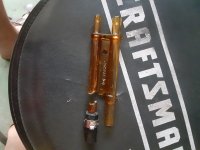Ok, so I went out on the water this morning and did some tests. The whole time I was using a 6 gallon 50:1 premix tank. As of yesterday evening I had done the following:
- Replaced old attwood fuel primer bulb with OEM primer bulb (minor point as I was not running the main gas tank that this was attached to).
- Removed oil reservoir, thoroughly cleaned and reinstalled on the boat. Replaced oil filter sock with OEM part and filled up oil tank with Quicksilver synthetic blend. Purged air from oil line going to the motor and reinstalled on VRO.
- Replaced damaged o-ring described in Post #29.
Here is what I observed from the tests:
1) I left the dock and within 3 minutes of going about 2000 RPM, the No Oil light came on and alarm sounded. When the alarm came on*, I immediately unplugged the VRO wiring and the light stayed on. 10 seconds or so later, I unplugged the wiring to the vacuum switch and the light immediately went off.
2) De-throttled the motor and restarted with VRO wiring connected and vacuum switch wiring disconnected (seeing if the problem is isolated to the vacuum wiring). After about 5-6 minutes of going at around 3000 RPM, the No Oil alarm came back on. After alarm came on, I maintained constant speed and unplugged the VRO wiring and within 1 minute, the No Oil light went off.
3) No Oil Test: Disconnected oil line coming from reservoir, vacuum wiring still disconnected from #2. Ran for 6 minutes around 2000 RPM, no light or alarm. Reconnected vacuum wiring and kept running at same speed for additional 4 minutes (10 total at this point), still no alarm. Alarm never went off during No Oil test.
4) Oil Consumption Test: After doing the No Oil test, I stopped boat, turned off motor and set up tube with oil. Restarted and drove boat at constant 1500 RPM. It took around 14 minutes for the VRO to consume the volume of oil within a 3"long x 1/4"ID section of hose. I have a video that I can post on youtube. Each time there is an engine pulse the oil level barely moves. I quit counting at 20 pulses lol. The no oil alarm I was seeking in the no oil test finally came on about 5 minutes into the oil consumption test, so it took around 15 minutes.

5) Low Oil Test: Pulled oil pickup out of reservoir. Within 2 minutes Low Oil light came on and alarm sounded*. Reinstalled oil pickup and light went back off.
My thoughts and conclusions:
- *All audible alarms were steady tone and lasted 10-12 seconds with no repetition. Fed, that image you posted up is a great find and I think it is spot on for my boat. I think all audible alarms are the same constant tone, though I have not confirmed this yet with the temperature sensor. Although the warning light will illuminate, It seems that the horn will not sound during an alarm if the engine is not running.
- I have pretty much out an overheat situation because I was constantly monitoring the engine temperature with a laser thermometer. The temperature stayed between 120-145*F measuring both the block and the starboard head, 800-3500 RPM.
- I think the main culprit is the VRO oil pump judging by the lack of oil consumption in #4. The vacuum switch seems iffy also as the light immedeatly went off when it was disconnected in #1. However, in this case it could have been a delayed reaction of the No Oil light disappearing after unplugging the VRO (making it appear as the vacuum switch solved the issue).
Sorry for the long post - alot of info to throw out there!




















